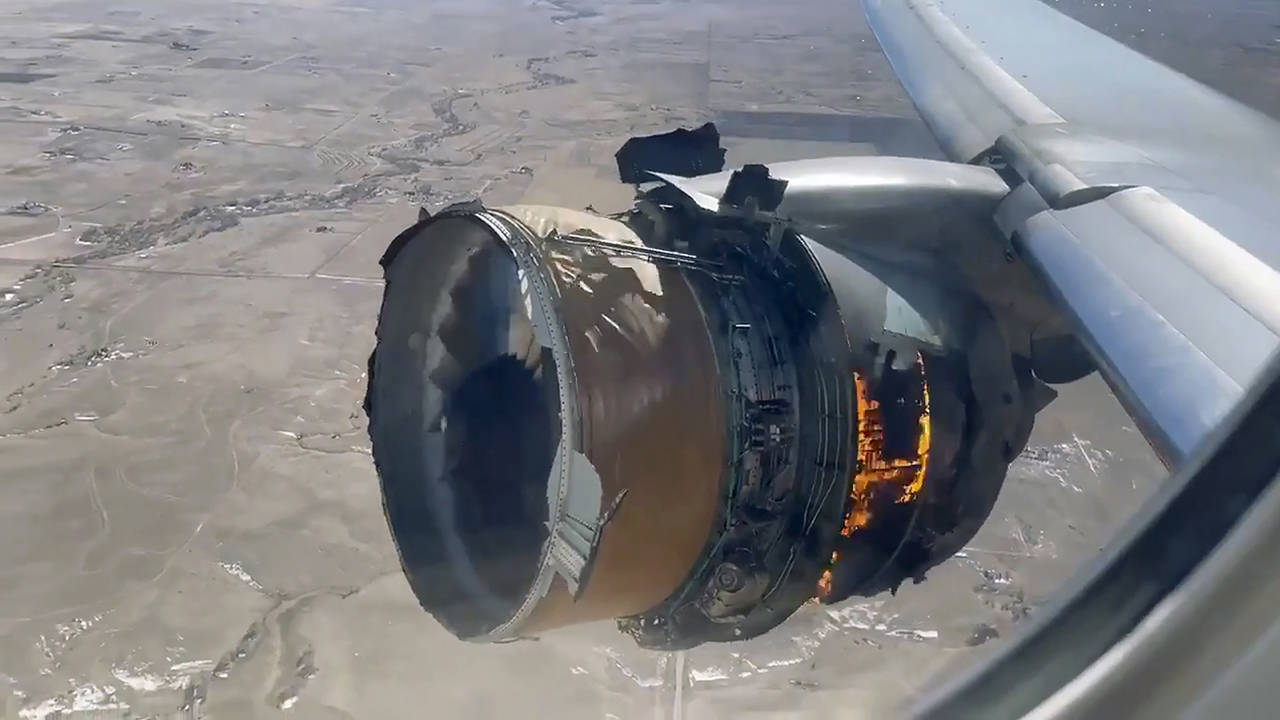By Alan Levin and Ryan Beene / Bloomberg
The jet engine fan blade that broke loose Saturday on a United Airlines plane near Denver, triggering a massive failure leading to the grounding of dozens of Boeing Co. 777s, resulted from metal fatigue, according to National Transportation Safety Board Chairman Robert Sumwalt.
A preliminary examination of fragments found after the episode that sent metal chunks raining on a suburban neighborhood suggested a crack that grew gradually over time prompted the failure, Sumwalt said Monday night.
NTSB investigators have begun reviewing maintenance records, interviewing the crew and examining the two crash-proof recorders recovered from the plane, Sumwalt said. They are also reviewing the potential similarity to other failures.
“Our mission is to understand not only what happened but why it happened so that we can keep it from happening again,” he added.
The engines were PW4077s built by Pratt & Whitney, a division of Raytheon Technologies Corp. On Dec. 4, a blade broke on a similar engine on a Japan Airlines Co. Ltd. 777-200 that had taken off from Okinawa on a flight to Tokyo.
On Sunday, Japan’s transport ministry ordered JAL and ANA Holdings Inc. to ground Boeing 777s equipped with the Pratt & Whitney engines until it’s clear whether countermeasures are needed.
After the December incident, the ministry instructed the airlines to increase inspections of the engines.
The Federal Aviation Administration had been looking into the Japan incident to evaluate whether to order additional inspections, but hadn’t yet reached a conclusion.
After the Okinawa episode, “the FAA reviewed previous inspection records and the engine maintenance history, conducted a metallurgical examination of the fan blade fragment to determine the cause of the fracture, and was evaluating whether to adjust blade inspections,” the agency said Monday night in a statement.
The right-side engine on United Flight 328 failed shortly after the plane took off from Denver bound for Hawaii. A pair of fan blades broke off, slamming into the structure at the front of the engine and tearing most of it loose.
Debris ranging from heavy metal objects to lighter weight insulation materials fell to the ground and passengers captured video of the mangled engine spewing flames.
Airlines including United have grounded their 777s powered with the Pratt & Whitney engines while they await inspections of existing fan blades to determine whether any more are at risk. There were 69 such aircraft in operation with another 59 in storage, according to Boeing.
The head of the FAA, Steve Dickson, on Sunday said the agency was preparing to issue an emergency directive requiring inspections.
“The FAA’s safety experts continue to review all the available data from the investigation of Saturday’s incident,” the agency said. “Following the team’s analysis, the FAA will issue an Emergency Airworthiness Directive.”
South Korea on Tuesday ordered its carriers to conduct checks. Korean Air Co. has 16 777 jets with the engines while Asiana Airlines Inc. has nine and Jin Air Co. operates four.
One of the broken fan blades on United flight lodged itself into an armored ring around the engine designed to prevent debris from escaping.
The pieces that came loose from the plane included most of the front of the engine, which is designed to produce smooth airflow into the engine and isn’t as protected against a failure. The NTSB, after a similar fan-blade failure on a Southwest Airlines Co. 737-700 in April 2018, called on the FAA and the European Aviation Safety Agency to examine whether those areas of engines were adequately protected.
Sumwalt didn’t address whether Saturday’s failure was similar to the Southwest episode, but said all of the debris from the engine appeared to have come from unprotected areas. That means the incident isn’t what is technically known as an “uncontained failure,” he said.
“From a practical point of view, from the flying public, it really doesn’t matter,” he said. “It was still an event that we don’t like to see.”
The engine debris hit parts of the plane, but didn’t cause significant damage, Sumwalt added.
A photograph released by the NTSB showed a large gouge beneath the wing where it joins the fuselage. But Sumwalt said that the damage occurred to a lightweight plastic cover over the area known as a fairing and it didn’t threaten the structure of the plane.
Inspections of Pratt & Whitney engines on the 777 had been conducted by airlines around the world after a similar failure on a United jet flying from San Francisco to Hawaii on Feb. 13, 2018. The FAA issued a directive in March 2019 ordering the action.
It required that the fan blades be inspected before reaching a total of 7,000 flights. It called for use of a technique called thermal acoustic imaging that is similar to an ultrasound for use in medicine. By bombarding the titanium blades with energy waves, defects within the metal can be detected.
Once those were completed, operators had to repeat the inspections within the next 1,000 flights, according to the earlier directive.
All 9,600 blades in service on the engines were inspected after that 2018 failure, the NTSB said after completing an investigation into the failure.
NTSB investigators concluded Pratt & Whitney employees had missed a growing crack in the blade during inspections in 2010 and 2015. The evidence of weakening metal was attributed to paint on the blade, the NTSB said.
Talk to us
> Give us your news tips.
> Send us a letter to the editor.
> More Herald contact information.

























